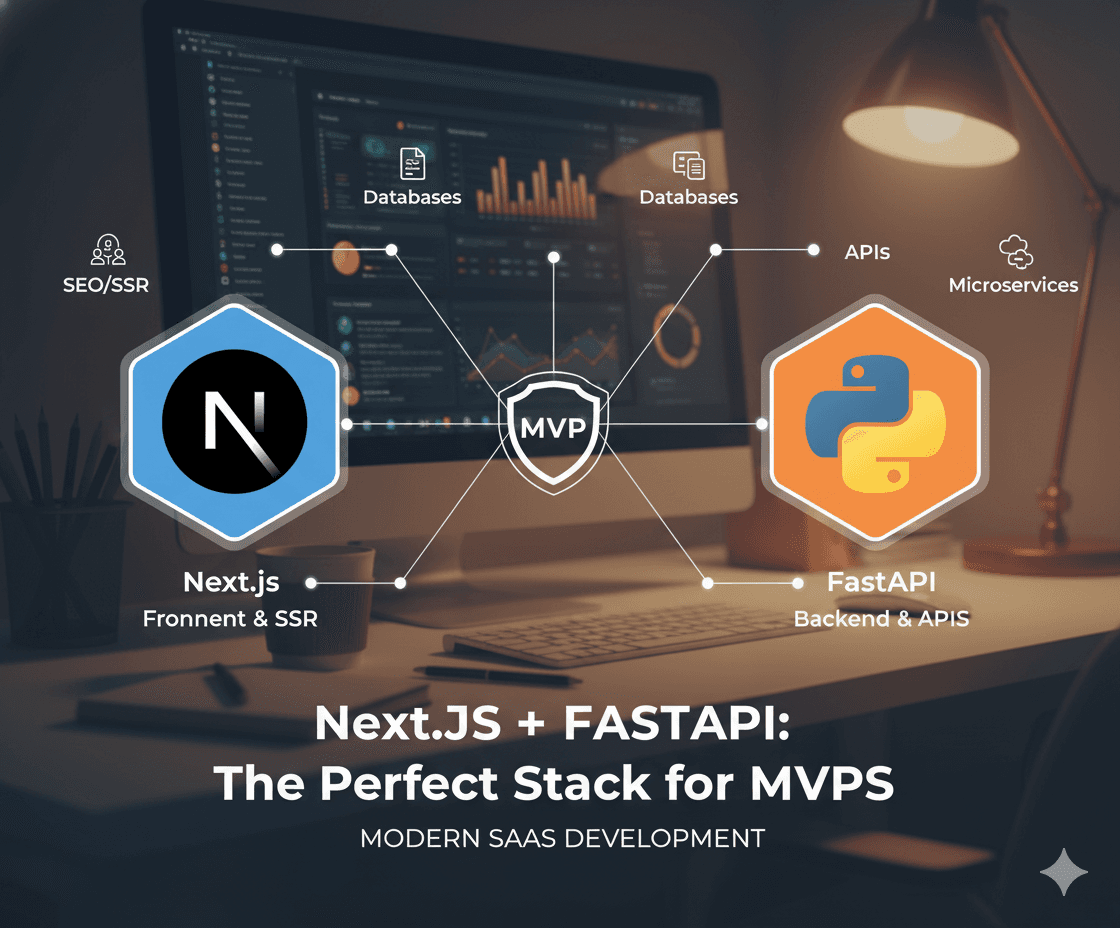10/17/2025
Next.js vs FastAPI for Modern SaaS: The Perfect Stack for MVPs
Next.js and FastAPI make an unbeatable pair for SaaS MVPs. Learn how to combine them for modern, scalable web apps with strong APIs, fast frontend rendering, an
By fathin@nightcoders.id

Why Picking the Right Stack Matters for SaaS
The wrong tech stack can slow your team, inflate costs, and make future scaling painful. SaaS founders often need to launch early, collect feedback, and iterate fast without sacrificing reliability.
Next.js and FastAPI make that possible.
Next.js gives you a production-ready frontend that can handle everything from static marketing pages to dynamic dashboards. FastAPI, on the other hand, provides a backend that is fast, typed, and developer-friendly. Together, they create a clean bridge between frontend and backend for SaaS MVPs.
What Is Next.js?
Next.js is a React framework built for performance and developer experience. It adds server-side rendering (SSR), static site generation (SSG), and API routes out of the box.
Key benefits for SaaS products:
SEO-friendly rendering for landing pages and blogs
Server and client components for dynamic dashboards
Built-in routing that simplifies structure
Edge and serverless support on Vercel or other hosts
TypeScript first approach for fewer runtime bugs
When you build SaaS with Next.js, your frontend remains flexible yet fast, able to handle both public and authenticated user areas.
What Is FastAPI?
FastAPI is a Python web framework designed for performance and clarity. It’s built on top of Starlette and Pydantic, giving you async endpoints, type checking, and automatic documentation.
Why it fits SaaS backends:
High performance due to async I/O
Automatic OpenAPI docs for your API
Strong typing with Pydantic models
Easy integration with databases, queues, and cloud services
Perfect for microservices and event systems
For teams familiar with Python, FastAPI feels natural. It also plays well with data science and AI integrations, making it ideal for SaaS products that need analytics or automation.
Why Combine Next.js and FastAPI?
Pairing these two creates a stack that covers both speed and control.
1. Clear Separation of Concerns
Keep the frontend lightweight and responsive on Vercel, while the backend runs securely on a VPS or containerized environment.
2. Type-Safe Communication
Use TypeScript on the frontend and Pydantic on the backend for typed contracts and fewer integration bugs.
3. Flexible Deployment
Deploy Next.js on Vercel for instant CI/CD.
Host FastAPI on Docker using your own VPS for stable APIs.
Connect through REST or GraphQL.
4. Easy Integration with Modern Tools
Add Supabase, Redis, or Celery workers to your backend without disrupting the frontend.
5. Perfect for MVP Speed
The stack is lean enough for early launch but strong enough to scale.
Example Architecture
/customer-app → Next.js 15 frontend /backend → FastAPI + PostgreSQL + Redis /workers → Celery or RQ for background jobsFlow
User action in the Next.js dashboard triggers API call to FastAPI
FastAPI validates data and pushes background jobs to Redis
Workers process jobs asynchronously
Frontend updates in real time with server responses
This pattern keeps requests fast and user experience smooth.
Deployment Workflow
Frontend (Next.js)
Deploy via Vercel
Configure environment variables (NEXT_PUBLIC_API_URL, NEXT_PUBLIC_SUPABASE_URL)
Automatic build on every push to main
Backend (FastAPI)
Deploy with Docker Compose
Include Nginx or Caddy for HTTPS
Use GitHub Actions for CI/CD (build, SSH, restart containers)
Both can live in a monorepo with clear boundaries and shared typing through OpenAPI schemas.
Real-World Use Case: Nightcoders’ Hybrid Setup
At Nightcoders, we use this architecture for client SaaS products such as Tokobux, where the frontend runs on Vercel and the backend runs on a VPS with Dockerized FastAPI, Redis, and Selenium workers.
This hybrid approach gives us:
Fast iteration for frontend updates
Full control over backend automation and networking
Stable, observable deployments for production workloads
Key Benefits for Startups
Area | Next.js | FastAPI | Combined Advantage |
|---|---|---|---|
Frontend Speed | ✅ SSR/SSG built in | — | Instant load, better SEO |
Backend Speed | - | ✅ Async I/O | Faster API responses |
Development | ✅ Hot reload | ✅ Type hints | Fewer bugs |
Scaling | ✅ Serverless ready | ✅ Docker ready | Horizontal scaling |
Integration | ✅ REST/GraphQL | ✅ Pydantic models | Easy API contracts |
Common Questions
Q: Can I run both Next.js and FastAPI on one domain? Yes. Host them on separate subdomains (like app.example.com and api.example.com) and configure CORS properly.
Q: Do I need a database layer for MVP? Not always. You can start with Supabase or SQLite, then move to PostgreSQL once you grow.
Q: Can I connect FastAPI directly to Next.js API routes? It’s better to keep them separate for scalability. Let Next.js handle UI and FastAPI handle core logic.
Q: How do I handle authentication between them? Use JWTs or Supabase Auth. Send tokens via HTTPS headers for secure communication.
JSON-LD Structured Data
<script type="application/ld+json"> { "@context": "https://schema.org", "@type": "TechArticle", "headline": "Next.js vs FastAPI for Modern SaaS: The Perfect Stack for MVPs", "description": "Learn how to combine Next.js and FastAPI to build modern, scalable SaaS MVPs with fast frontends, secure APIs, and simple CI/CD pipelines.", "author": { "@type": "Organization", "name": "Nightcoders" }, "publisher": { "@type": "Organization", "name": "Nightcoders", "logo": { "@type": "ImageObject", "url": "https://nightcoders.id/logo.png" } }, "mainEntityOfPage": "https://nightcoders.id/blog/nextjs-fastapi-saas-stack", "datePublished": "2025-10-15", "dateModified": "2025-10-15" } </script>Conclusion
Next.js and FastAPI make a clean, modern foundation for SaaS MVPs. You get the flexibility of React on the frontend and the performance of Python on the backend. Together they let you move faster, deploy safer, and scale smoother.
👉 Build your MVP with Nightcoders, we use this exact stack to help startups launch production-ready SaaS in weeks, not months.
